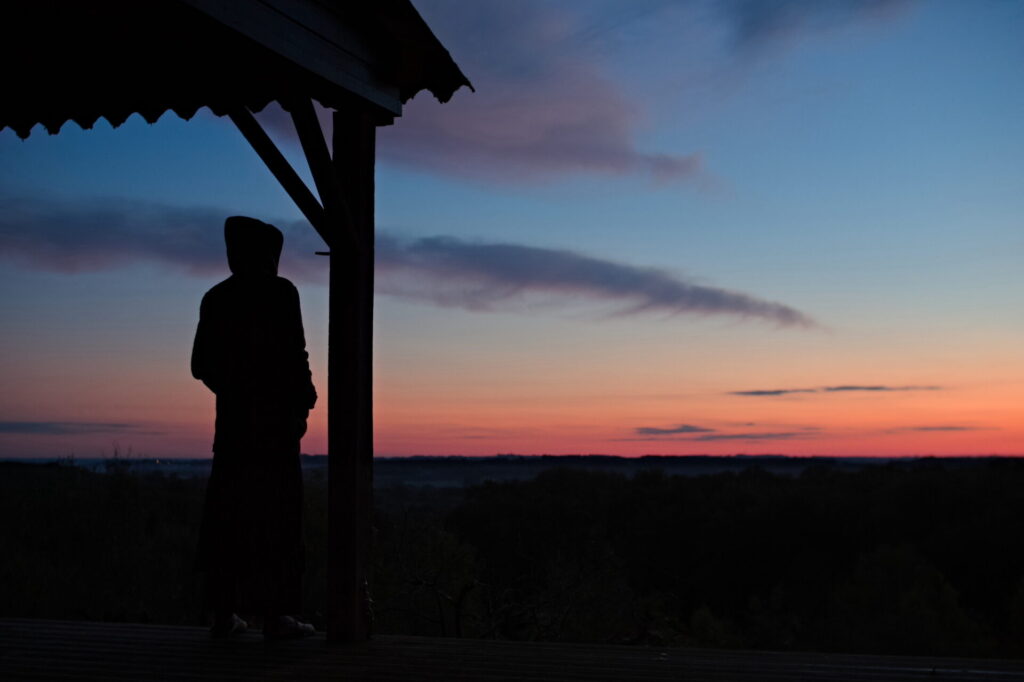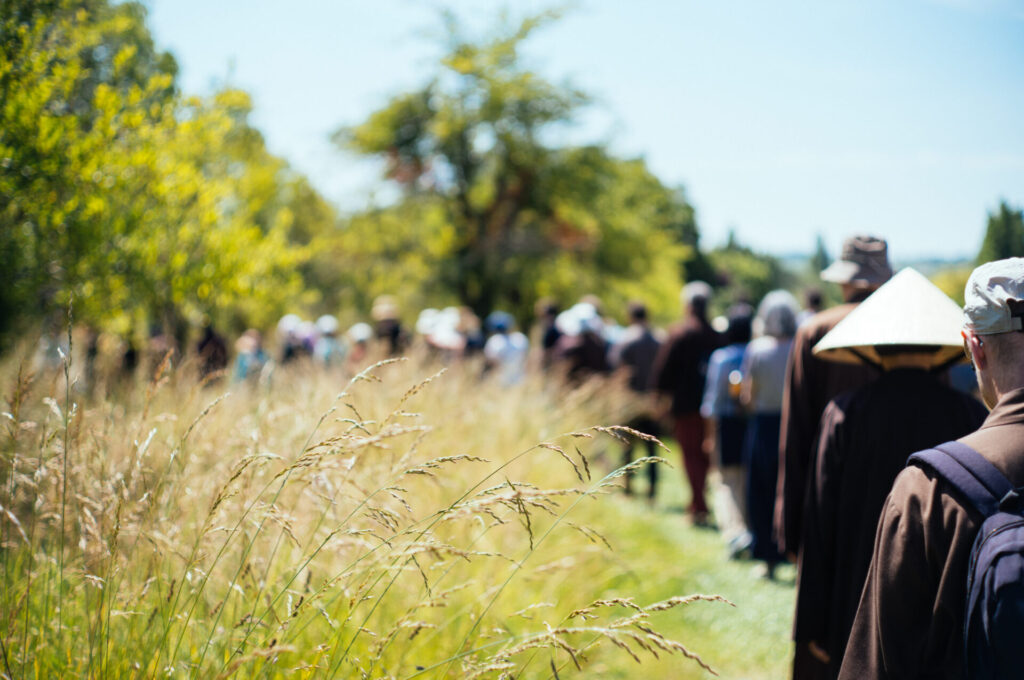We offer a selection of teachings from Thich Nhat Hanh and other Plum Village Dharma teachers on embracing the painful feeling of loneliness.
Almost all of us will experience feelings of loneliness at some point in our lives. Thich Nhat Hanh (Thay) has described loneliness as the “ill-being of our time”. A video of his teaching entitled, Loneliness and the Illusion of Connection, has 1.3 million views, which is a testament to how common this feeling is. In that video and elsewhere, Thay and other Plum Village Dharma teachers have offered us ways to resist our habitual responses to loneliness, and instead connect more deeply with ourselves, other people, and the world around us. Here are five of them.
[Links to all sources are provided at the end of the article to create a more mindful reading experience.]
1. Resist the “illusion of connection”
What is the “illusion of connection” Thay was referring to? He observed that to try to get rid of the painful “vacuum inside of us” that is loneliness, we tend to reach out to connect with others to try and dispel that feeling, and we are likely to do so through the many devices such as smartphones that technology supplies us with to stay connected. He observed that checking emails, posting, and sharing on social media several times a day does not alleviate our loneliness:
We always stay connected but we continue to feel lonely. This is what happens in the present moment in our modern civilization…We think that with these devices we can connect, but we cannot really connect. How can you connect with another person when you cannot connect with yourself?
Since Thay was speaking in 2012, the addictive capacities of our smartphones have only increased. A couple of years ago on The Way Out is In Podcast, Brother Phap Huu referenced a holiday season meme with words: “Great, we’re all going to come together, sit at the same table, but we’re all just going to stare at our phones because we don’t know how to connect.” This is something that made him laugh but also scared him as it conveys the reality of “modern-day suffering.”
If we feel we are using our phones more than we like in a (potentially subconscious) search for connection, we should be kind to ourselves given the lengths technology companies go to make their products addictive. And there are other methods we might use to try and not feel loneliness, which could involve relating in unhealthy ways to food, alcohol, drugs, or sex. However we do it, it might be helpful to recognize the ways we might be seeking the “illusion of connection”, to observe whether they are beneficial to us, and if not, to try something else.
2. Go “home” and connect with yourself

There is a paradox in what Thay offers us to soothe the pain of loneliness: to connect with ourselves, as he describes it, to come “home”. This might not seem intuitive at first. Our instinct might be to reach outwards and instinctively we might wish to do anything to avoid the difficult feelings inside of us. But echoing Thay, Sister Jina has pointed out that we can be surrounded by people and still feel lonely:
Being alone and feeling lonely for me are two different things. We can be alone and not feel lonely and we can feel lonely and be with a lot of people and the difference for me is feeling connected. When I am alone, and I feel connected, with myself first of all, and with other people even though they’re not physically there, I don’t feel lonely. But if I’m not very connected to myself and there is something I’m not looking at or I’m avoiding so that I’m not really with myself, then it’s also very difficult to feel connected to others. Then there’s a sense of loneliness, even when there are people around us. Loneliness can be sharper and more poignant while being in a crowd than when we are alone.
So how do we connect to ourselves? Thay tells us:
You just need to sit down and breathe in mindfully, and in a few seconds, you connect with yourself. You know what is going on in your body, your feelings, your emotions, your perceptions and so on. You are already home and able to take care of home…
As you sit and become aware of the sensations of your breathing and the sensations of your body, Thay goes on to give an example of how, when you feel ready to, you can start to take care of the difficult feelings you might encounter:
I'm aware of my feeling of loneliness, of sadness, of fear, or anxiety. I smile to the feelings of loneliness, fear, or anxiety. I say, "My dear loneliness. I know you are there, I am home to take care of you.” And you make peace with your loneliness. You make peace with your fear. There is a wounded child in you. You recognize her, you recognize him, and you embrace him or her tenderly in your arms. That is the act of going home and taking care of home.
Sitting meditation is not the only way to return “home”, while walking, you can bring your awareness to the soles of your feet and their contact with the ground, to the movements in your feet and legs, or to your body and breathing:
Every time you make a step whether you are breathing in or out, you can go back to yourself every step, brings you home to the here and now so that you can connect with yourself, your body, your feelings. That is real connection.
In fact, according to Thay, “every act” whether it be drinking a cup of tea or coffee, or doing cleaning and housework, “if done in mindfulness, can help you go home to yourself.”
3. Learn to Love

Thay goes on to say that if we can find a home for ourselves, we can help a partner find their home. In a Q+A answer on loneliness, he spoke about how “loneliness can be transformed into fulfillment if we learn how to love”:
Love is an art. Love is to connect oneself with others. You can begin by connecting yourself with one person and if you succeed you will be able to connect with everyone and everything. True love has the power to heal and bring fulfillment. Love means to offer well-being, peace, and fulfillment…. Love is made of understanding and compassion. If you do not understand the other person you cannot love him or her. The teaching of true love is very clear in this tradition, to love means to be there and to look and listen deeply in order to see the suffering, the loneliness, and the difficulty of the other person. When you have understood that person, you begin to love already. When we feel there is one person who understands us, then the loneliness in us disappears because we are being understood by someone.
4. Experience interbeing with nature

It’s not just other people we can connect to though. Using the insight of interbeing, the deep relatedness of all things, we can begin to feel the intimate connection we have to the natural world around us:
You feel lonely because you have not seen the connection between you and other beings. You have not seen the connection between you and the air, the sunshine, the water, the people, the animals, the plants, and the minerals. You are lonely because you believe there is a separate self, so the insight of no self, and the insight of interbeing can help solve the problem of loneliness. Everything, and everyone is there for you, that is the truth. The sunshine is there for you. If there is no sunshine, there is no life on earth and you cannot be there. You have to see the deep connection between you and the sunshine, you are made of sunshine.
[We can] breathe, walk, sit in such a way that you can get connected with the earth, with the stars, with the trees, with air, and with the sunshine. Life is a wonder. There are so many wonders of life available.
Lay Dharma teacher David Viofora gives a vivid account of connecting with nature in this kind of way when due to Covid-19, he was isolated from other people:
I hiked to our Lily Pond a few days each week, sitting on a sloping granite slab next to a giant pine at the edge of the frozen lake. A hot water thermos, down jacket, thick scarf, and blankets kept me comfortable enough to sit and walk for a few hours next to the thick icy pond, my steadfast companion. If I couldn’t be near people due to my anxiety or the pandemic, at least the lake was always there for me—as were the granite rock, the sturdy pine, the sunset, and my breath. When humans are less available, animals and plants take on new dimensions of siblinghood, and the wounded spaces of my heart found a peaceful refuge and everlasting companionship. No matter how cold my heart felt, it was no colder than the frozen lake and pine. We were all thawing out slowly together, reflecting each other’s true nature.
5. Come home, together
There are ways to come home to ourselves in the way Thay described at the same time as connecting deeply with other humans.
This is what happens at Plum Village mindfulness retreats and at an in-person or online sangha, which is the Buddhist name for communities that practice mindfulness and meditation together. At either a retreat or sangha there are chances to practice sitting and walking meditation with others, the collective energy and intention can be a great support which makes it easier to go against the grain and come home to ourselves.
Often there are also opportunities for Dharma sharing, a practice of mindful speaking and listening, where people are invited, if they wish to, to speak uninterrupted about their current experiences. The atmosphere created in Dharma sharing often allows for a quality of communication that is not possible in day-to-day conversations and can be a deeply connecting experience.

Sources
- Thich Nhat Hanh: Loneliness and the Illusion of Connectedness (YouTube)
- The Way Out is In Podcast: Episode 43 – Transforming Loneliness
- Sister Jina: A Mindfulness Christmas Part 3 – Loneliness
- Thich Nhat Hanh Q+A: How do I take care of loneliness? (YouTube)
- David Viofora: Better Way to Live Without Lonelines (The Mindfulness Bell)








